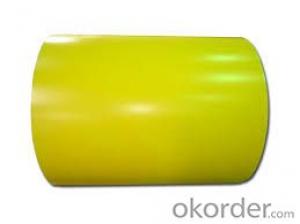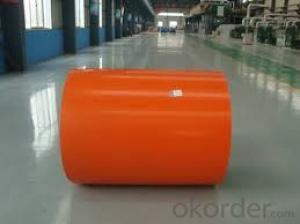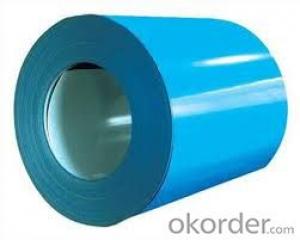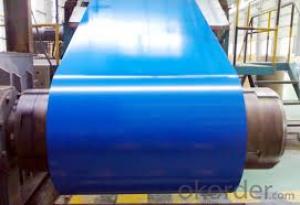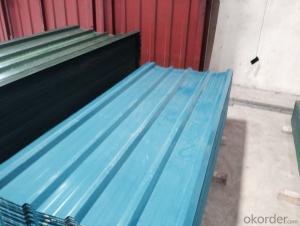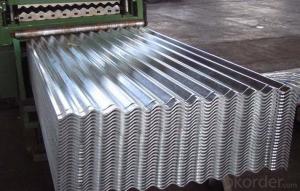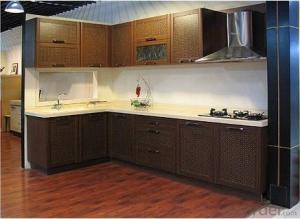Prepainted galvanized Corrugated plate / sheet in China
- Loading Port:
- Tianjin
- Payment Terms:
- TT OR LC
- Min Order Qty:
- 100 m.t.
- Supply Capability:
- 500000 m.t./month
OKorder Service Pledge
OKorder Financial Service
You Might Also Like
Brief Introduction of Prepainted Galvanized Steel:
Prepainted Galvanized Steel usually refers to have substrate processed with surface processed and coated then(roller coated )or bonded organic thin film and baked, and it is able to be processed to final production .
Prepainted Galvanized Steel qualified with excellent decorative, formability, corrosion resistance, coating adhesion ,can keep for a long time as well as maintain fresh color .For color coated steel sheet can obtain good economic benefit by steel belt wood ,efficient in construction and save energy ,prevent pollution etc. Which is an ideal material; for manufacturing board.
Description of Prepainted Galvanized Steel:
1.material : galvanized steel sheet / prepainted galvanized sheet
2.sheet thickness : normal use 0.3-0.6mm
3.length: any length, according to the transportation, generally less than 12m
4.color: standard color: red, blue, white, grey; special color: according to RAL color
Specification of Prepainted Galvanized Steel:
prepainted corrugated steel plate | |
material | galvanized steel sheet |
prepainted galvanized sheet | |
model No. | types of roof sheets |
sheet thickness | normal use 0.3-0.6mm |
length | any length, according to the transportation, generally less than 12m |
color | standard color:red, blue, white, grey |
special color: according to RAL color | |
characteristic | 1:weather proof |
2:heating insulation | |
3:fireproof | |
4:anti-rust | |
5:sound insulation | |
6:long life span: more than 15 years | |
advantages | 1.low foundation cost |
2.easy construction | |
3.time saving | |
4.labor saving | |
application field | 1:construction:prefabricated house, steel house, mobile house, modular house, villa, bungalow design, portable house/carbin, ready made house, kiosk booths, steel building... |
2:container manufacturing | |
3:household appliances and furniture | |
4:vehicle and vessel manufacturing | |
5:others,like machinery structual parts, manufacturing shells of motors and so on | |
packing | plastic film, pallet or as your request |
Applications of Prepainted Galvanized Steel
It can be widely used in transportation, light industry, civil usage and farming. It is also the perfect building material in construction for making steel roofing, insulation panel, corrugate sheet, facade wall, shutters, T-bar and home appliance.
Packaging & Delivery of Prepainted Galvanized Steel
The packing of coils consists of anti-damp paper, PVC film, hardboard paper, steel box, strapped with steel strips, fitted with locks and edge protectors and guarantees the optimal condition of the delivered goods. Each coil can be additionally fitted with wooden/steel skids(eye to the side) or wooden pallets(eye to the sky).
Images of Prepainted Galvanized Steel:
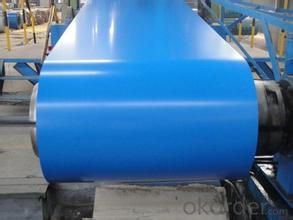
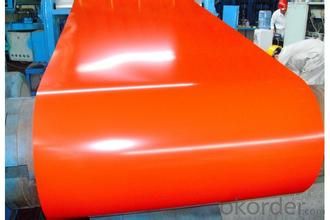
- Q:What is the maximum size of the steel sheets available?
- The specific supplier or manufacturer determines the maximum size of available steel sheets, which can vary. Generally, steel sheets come in a variety of sizes, ranging from 36 inches to 72 inches in width, and 96 inches to 240 inches in length. However, it should be noted that these dimensions may differ depending on the supplier's capabilities and the customer's specific requirements. Therefore, it is recommended to directly contact a supplier or manufacturer for information regarding the largest size of steel sheets they can offer.
- Q:Can steel sheets be used in corrosive chemical environments?
- Yes, steel sheets can be used in corrosive chemical environments, but the specific type of steel and its corrosion resistance properties are important factors to consider. Stainless steel, for example, is commonly used in corrosive environments due to its high resistance to corrosion. It contains a minimum of 10.5% chromium, which forms a protective oxide layer on the surface of the steel, preventing further corrosion. This makes stainless steel sheets suitable for a wide range of corrosive chemical environments, including those with acids, alkalis, and salts. However, it is essential to choose the correct grade of stainless steel that is compatible with the specific corrosive chemicals present in the environment. Additionally, protective coatings or surface treatments can further enhance the corrosion resistance of steel sheets in harsh chemical environments. It is important to consult with corrosion experts or engineers to determine the most suitable steel grade and protective measures for a particular corrosive chemical environment.
- Q:What are the common thicknesses for stainless steel sheets?
- The common thicknesses for stainless steel sheets range from 0.4mm to 6.0mm, with the most commonly used thicknesses being 0.8mm, 1.0mm, 1.2mm, 1.5mm, and 2.0mm.
- Q:What is the process of laminating steel sheets?
- The process of laminating steel sheets involves several steps to create a composite material that is stronger and more durable than traditional steel. First, the steel sheets are cleaned and prepped to remove any impurities or contaminants. This is important to ensure a strong bond between the layers and prevent any defects in the final product. Next, a layer of adhesive is applied to one or both sides of the steel sheets. The adhesive can be a thermosetting resin or a thermoplastic material, depending on the desired properties of the laminated steel. After the adhesive is applied, the steel sheets are stacked together, with the adhesive layer(s) in between. The sheets are then subjected to high temperature and pressure to initiate the bonding process. This can be done using a hydraulic press or a hot rolling mill. The combination of heat and pressure causes the adhesive to melt and flow, creating a strong chemical bond between the steel sheets. The high pressure ensures that the adhesive is evenly distributed and fills any gaps or irregularities between the sheets. Once the bonding process is complete, the laminated steel sheets are cooled and trimmed to the desired size and shape. They can then be further processed, such as by cutting, bending, or welding, to meet specific application requirements. Overall, the process of laminating steel sheets involves cleaning and prepping the sheets, applying adhesive, stacking the sheets, subjecting them to high temperature and pressure, cooling, and finalizing the shape. This process results in a composite material with improved strength, corrosion resistance, and other desirable properties compared to traditional steel.
- Q:How do steel sheets perform in low-temperature environments?
- Steel sheets generally perform well in low-temperature environments. The mechanical properties of steel, such as strength and toughness, are not significantly affected by low temperatures. Steel has a low coefficient of thermal expansion, which means it does not contract or expand drastically when subjected to temperature variations. This property allows steel sheets to maintain their shape and structural integrity in cold conditions. Moreover, steel is also highly resistant to brittle fracture at low temperatures. It has a good impact resistance, meaning it can absorb energy without fracturing. This makes steel sheets suitable for applications in low-temperature environments where materials need to withstand heavy loads or sudden impacts, such as in cold storage facilities or offshore structures in Arctic regions. However, it is worth noting that some types of steel, particularly those with high carbon content or low alloy steels, can exhibit reduced toughness and ductility at extremely low temperatures. In such cases, special precautions may be necessary, such as using steel grades specifically designed for low-temperature applications or implementing proper insulation measures to prevent rapid temperature changes. Overall, steel sheets are generally reliable and perform well in low-temperature environments due to their strength, toughness, and resistance to brittle fracture. However, the specific performance of steel in cold conditions may vary depending on the composition and quality of the steel used.
- Q:Can steel sheets be bent without causing damage?
- Yes, steel sheets can be bent without causing damage, provided that the bending process is done carefully and within the limits of the material's properties. Steel sheets are commonly bent using various techniques such as press brake bending or roll bending. These processes involve applying controlled force and pressure to the sheet to achieve the desired shape without causing any permanent deformation or damage. The ability to bend steel sheets without damage depends on several factors, including the thickness and grade of the steel, the bending radius, and the equipment and technique used. Thinner sheets are generally more flexible and easier to bend, while thicker sheets may require higher forces and specialized equipment. It is essential to consider the steel's tensile strength, yield strength, and elongation properties to ensure that the bending process does not exceed its limits. Excessive bending can lead to cracks, fractures, or permanent deformations, compromising the sheet's structural integrity. To prevent damage during bending, it is crucial to follow proper bending techniques and guidelines. This includes using appropriate tooling, ensuring even distribution of force, and avoiding sharp changes in direction or excessive bending angles. Additionally, preheating the steel sheet can make it more pliable and reduce the risk of damage. In summary, steel sheets can be bent without causing damage, but it requires careful consideration of the material's properties, proper equipment, and adherence to bending guidelines. By employing the right techniques and precautions, steel sheets can be successfully bent into various shapes and forms while maintaining their structural integrity.
- Q:What's the density of the 0.5 color steel plate?
- We often see the color steel plate refers to the processing of sheet metal, the thickness of about 50~100mm, it is composed of the middle filler and two sides of color steel plate. Among them, the color plate thickness of 0.4mm, 0.5mm, 0.6mm and other different thickness, the middle layer can be polyurethane, rock wool or foam plastic. Because of the special profiles, the construction of the building with colored steel plate is very fast (such as the Xiaotangshan hospital in SARS), but the strength is low. The substrate of the color coated steel plate is a cold rolled substrate, a hot-dip galvanized substrate and an electro galvanized substrate. The coating types can be divided into polyester, silicon modified polyester, vinylidene fluoride and two plastic sol. The surface state of color coated steel sheet can be divided into coated plate, embossed plate and printed board.
- Q:What are the different methods of surface preparation for steel sheets?
- There are several methods of surface preparation for steel sheets, including mechanical cleaning, chemical cleaning, and abrasive blasting. Mechanical cleaning involves the use of wire brushes, sanding, or grinding to remove surface contaminants and oxides. Chemical cleaning utilizes acid or alkaline solutions to dissolve grease, oil, and rust from the steel surface. Abrasive blasting is a common method that uses high-pressure air or water to propel abrasive particles onto the steel surface, effectively removing scale, rust, and other impurities. These methods ensure proper adhesion of coatings and improve the overall durability and longevity of steel sheets.
- Q:What is the difference between a hot rolled and pickled steel sheet?
- A hot rolled steel sheet is made by rolling a heated slab of steel through a series of large rollers, resulting in a thick and rough surface finish. On the other hand, a pickled steel sheet undergoes an additional process called pickling, where the surface of the hot rolled steel is treated with an acid solution to remove impurities and create a smooth and clean surface finish. So, the main difference between the two is the surface finish - hot rolled steel has a rougher surface, while pickled steel has a smoother and cleaner surface.
- Q:What is the difference between a smooth and expanded metal steel sheet?
- A smooth metal steel sheet has a flat surface with no perforations or raised patterns, while an expanded metal steel sheet has a textured surface with small diamond-shaped openings that are created by stretching the metal.
1. Manufacturer Overview |
|
|---|---|
| Location | |
| Year Established | |
| Annual Output Value | |
| Main Markets | |
| Company Certifications | |
2. Manufacturer Certificates |
|
|---|---|
| a) Certification Name | |
| Range | |
| Reference | |
| Validity Period | |
3. Manufacturer Capability |
|
|---|---|
| a)Trade Capacity | |
| Nearest Port | |
| Export Percentage | |
| No.of Employees in Trade Department | |
| Language Spoken: | |
| b)Factory Information | |
| Factory Size: | |
| No. of Production Lines | |
| Contract Manufacturing | |
| Product Price Range | |
Send your message to us
Prepainted galvanized Corrugated plate / sheet in China
- Loading Port:
- Tianjin
- Payment Terms:
- TT OR LC
- Min Order Qty:
- 100 m.t.
- Supply Capability:
- 500000 m.t./month
OKorder Service Pledge
OKorder Financial Service
Similar products
New products
Hot products
Hot Searches
Related keywords
